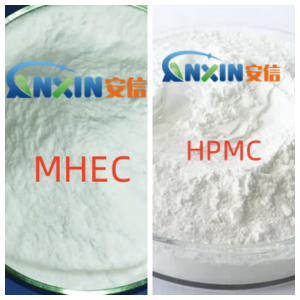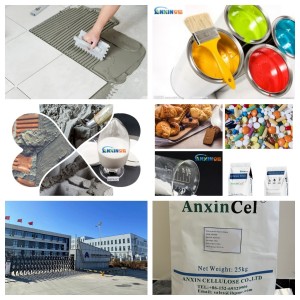In modern building materials, high-molecular-weight cellulose ether additives are widely used in mortars, putty powders, tile adhesives, and insulation systems to improve water retention, workability, and bond strength. Methyl hydroxyethyl cellulose (MHEC) and hydroxypropyl methylcellulose (HPMC) are the two most common types of cellulose ethers. Both are non-ionic cellulose ethers, but differ in their structural substituents, performance, and application characteristics.
1. Chemical Structure Differences
HPMC is a cellulose ether substituted with methoxy and hydroxypropyl groups, exhibiting excellent solubility and stability. The introduction of hydroxypropyl groups in its molecular structure enhances its hydrophilicity and flexibility. MHEC, on the other hand, is a cellulose ether substituted with methoxy and hydroxyethyl groups. It has a relatively simple structure, slightly lower molecular polarity, and stronger hydrophilicity, but is slightly less flexible than HPMC. Overall, HPMC’s molecular structure is more conducive to forming stable colloidal solutions, while MHEC is more soluble and disperses faster in water.
2. Solubility and Dispersibility
MHEC generally dissolves faster than HPMC, especially in cold water. It disperses quickly and forms a homogeneous solution, making it suitable for building materials that require rapid slurry preparation. HPMC, on the other hand, forms a surface coating effect during dissolution, requiring time to fully swell and dissolve. However, the dissolved system exhibits greater uniformity and stability. Therefore, MHEC is more advantageous in applications requiring rapid mixing and application, while HPMC is more suitable for products that prioritize uniformity and stability.
3. Water Retention Comparison
Water retention is a key indicator of the performance of cellulose ethers in materials such as mortar and putty. Generally speaking, HPMC exhibits superior water retention compared to MHEC. This is because the hydroxypropyl groups in HPMC introduce a stronger hydrophilicity into the molecular chain, enabling it to retain water longer in coatings or mortar systems, preventing the material from drying out excessively and ensuring sufficient hydration of the cement or gypsum. While MHEC also exhibits good water retention, its water retention is somewhat less effective in extremely dry environments or on highly absorbent substrates.
4. Thickening and Thixotropic Properties
In terms of thickening properties, both MHEC and HPMC significantly increase the viscosity of mortars and coatings, improving workability. MHEC’s solution viscosity increases rapidly, with a noticeable initial thickening, making it suitable for construction processes requiring rapid shaping. HPMC, on the other hand, exhibits superior thixotropy and flow control, ensuring smooth application while preventing sagging. Therefore, HPMC offers a significant advantage in systems requiring high workability, such as tile adhesives and plaster mortars.
5. Temperature Resistance and Stability
In terms of temperature resistance, HPMC generally outperforms MHEC. HPMC maintains excellent water retention and thickening properties even in high-temperature environments, making it suitable for use in high-temperature summer construction or in humid southern China. MHEC, on the other hand, exhibits slightly less stability in high-temperature conditions, with some properties experiencing a decrease. Therefore, HPMC is more suitable for projects with demanding construction conditions.
6. Application Cost and Applicable Applications
MHEC has a relatively simple production process and is generally cheaper than HPMC. Therefore, it is widely used in price-sensitive markets, such as in mid- and low-end products like standard putty powder and interior wall mortar. HPMC, on the other hand, has a more comprehensive range of properties and is suitable for products with higher performance requirements, such as tile adhesives, exterior wall insulation mortars, and self-leveling mortars. Some manufacturers also use a blend of MHEC and HPMC to reduce costs while maintaining performance.
Both construction-grade MHEC and HPMC are important cellulose ether additives, but their application targets differ. MHEC offers good solubility and low cost, making it suitable for basic applications. HPMC, with its strong water retention, excellent workability, and high temperature resistance, is suitable for high-performance building materials. Construction companies should choose or combine the two based on their specific construction environment, performance requirements, and budget to achieve optimal results and economic benefits.
Post time: Sep-28-2025








